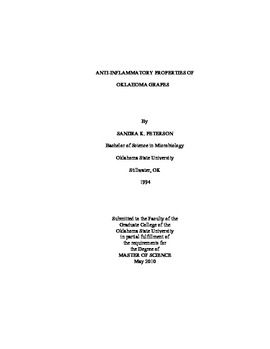| dc.contributor.advisor | Lucas, Edralin A. | |
| dc.contributor.author | Peterson, Sandra Kay | |
| dc.date.accessioned | 2014-04-15T22:01:28Z | |
| dc.date.available | 2014-04-15T22:01:28Z | |
| dc.date.issued | 2010-05-01 | |
| dc.identifier.uri | https://hdl.handle.net/11244/9264 | |
| dc.description.abstract | Many debilitating chronic conditions are linked to chronic inflammation. Recent studies have indicated that a relationship exists between phenolic compounds found in grapes and the reduction of chronic inflammation. The increasing trend in Oklahoma towards grape production has sparked the need to understand the health benefits associated with grapes grown locally, including their anti-inflammatory properties. Increased knowledge of the health benefits of grapes may help grape growers promote their products and increase their consumption which will help Oklahoma's viticulture and agritourism business. The hypothesis of the study is that the varieties of Oklahoma grapes with high concentrations of total phenolic compounds will have the greatest impact on decreasing markers of inflammation in vitro. The specific aims of the study were to: (1) determine the phenolic content, anti-oxidant capacity, and anti-inflammatory properties of juice from different varieties of grapes grown in Oklahoma; (2) assess the in vitro anti-inflammatory properties of extract from Oklahoma grape varieties with high and low total phenolics content (five varieties each) using lipopolysaccharide (LPS)-stimulated RAW 264.7 macrophages; and (3) to compare the effect of the grape extract from an Oklahoma grape variety to that of resveratrol on the expression of inflammatory genes in LPS-stimulated macrophages. The majority of phenolic compounds are found in the skin and seeds. Generally, purple grapes have more total phenolics and anthocyanins than the white grapes. A high total phenolic content did not necessarily represent a high anti-oxidant capacity. Some white grape varieties with low total phenolic content had a strong anti-oxidant capacity indicating that a phenolic compound found in some white grapes may also be a strong anti-oxidant. In vitro investigation of the grape extracts determined that both high and low total phenolic concentrations decreased NO production in LPS-stimulated macrophages, again, indicating that it is not the concentration of phenolics but the type of phenolic compound responsible for reducing inflammation. Resveratrol and the 1% dose of Rubaiyat grape extract reduced the gene expression of IL-6 and iNOS to the level of the unstimulated macrophage. Investigation on the types of phenolic compounds present in the different grape varieties may aid in determining the anti-inflammatory properties. | |
| dc.format | application/pdf | |
| dc.language | en_US | |
| dc.publisher | Oklahoma State University | |
| dc.rights | Copyright is held by the author who has granted the Oklahoma State University Library the non-exclusive right to share this material in its institutional repository. Contact Digital Library Services at lib-dls@okstate.edu or 405-744-9161 for the permission policy on the use, reproduction or distribution of this material. | |
| dc.title | Anti-Inflammatory Properties of Oklahoma Grapes | |
| dc.type | text | |
| dc.contributor.committeeMember | Smith, Brenda J. | |
| dc.contributor.committeeMember | Stafne, Eric | |
| osu.filename | Peterson_okstate_0664M_10907.pdf | |
| osu.college | Human Environmental Sciences | |
| osu.accesstype | Open Access | |
| dc.description.department | Department of Nutritional Sciences | |
| dc.type.genre | Thesis | |
| dc.subject.keywords | grapes | |
| dc.subject.keywords | inflammation | |
| dc.subject.keywords | oklahoma | |
| dc.subject.keywords | polyphenol | |
